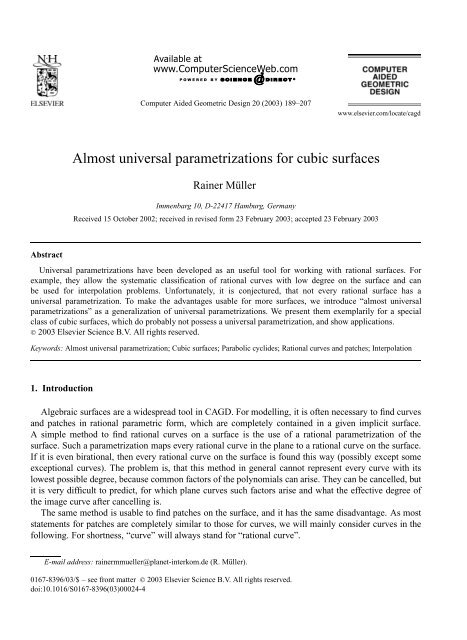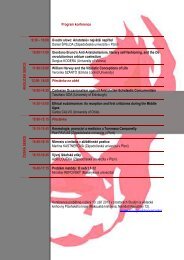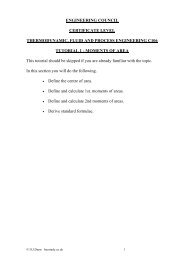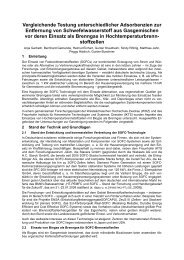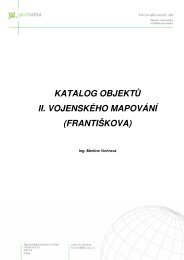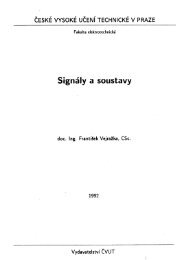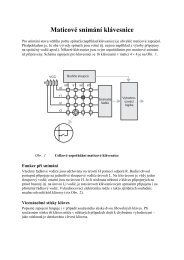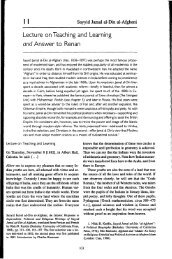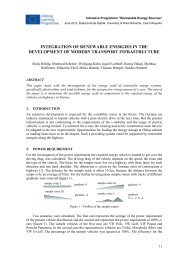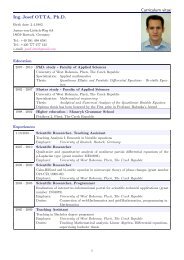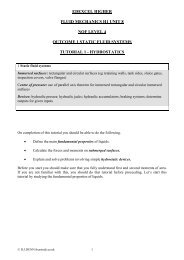Almost universal parametrizations for cubic surfaces
Almost universal parametrizations for cubic surfaces
Almost universal parametrizations for cubic surfaces
You also want an ePaper? Increase the reach of your titles
YUMPU automatically turns print PDFs into web optimized ePapers that Google loves.
Computer Aided Geometric Design 20 (2003) 189–207<br />
www.elsevier.com/locate/cagd<br />
<strong>Almost</strong> <strong>universal</strong> <strong>parametrizations</strong> <strong>for</strong> <strong>cubic</strong> <strong>surfaces</strong><br />
Rainer Müller<br />
Immenbarg 10, D-22417 Hamburg, Germany<br />
Received 15 October 2002; received in revised <strong>for</strong>m 23 February 2003; accepted 23 February 2003<br />
Abstract<br />
Universal <strong>parametrizations</strong> have been developed as an useful tool <strong>for</strong> working with rational <strong>surfaces</strong>. For<br />
example, they allow the systematic classification of rational curves with low degree on the surface and can<br />
be used <strong>for</strong> interpolation problems. Un<strong>for</strong>tunately, it is conjectured, that not every rational surface has a<br />
<strong>universal</strong> parametrization. To make the advantages usable <strong>for</strong> more <strong>surfaces</strong>, we introduce “almost <strong>universal</strong><br />
<strong>parametrizations</strong>” as a generalization of <strong>universal</strong> <strong>parametrizations</strong>. We present them exemplarily <strong>for</strong> a special<br />
class of <strong>cubic</strong> <strong>surfaces</strong>, which do probably not possess a <strong>universal</strong> parametrization, and show applications.<br />
© 2003 Elsevier Science B.V. All rights reserved.<br />
Keywords: <strong>Almost</strong> <strong>universal</strong> parametrization; Cubic <strong>surfaces</strong>; Parabolic cyclides; Rational curves and patches; Interpolation<br />
1. Introduction<br />
Algebraic <strong>surfaces</strong> are a widespread tool in CAGD. For modelling, it is often necessary to find curves<br />
and patches in rational parametric <strong>for</strong>m, which are completely contained in a given implicit surface.<br />
A simple method to find rational curves on a surface is the use of a rational parametrization of the<br />
surface. Such a parametrization maps every rational curve in the plane to a rational curve on the surface.<br />
If it is even birational, then every rational curve on the surface is found this way (possibly except some<br />
exceptional curves). The problem is, that this method in general cannot represent every curve with its<br />
lowest possible degree, because common factors of the polynomials can arise. They can be cancelled, but<br />
it is very difficult to predict, <strong>for</strong> which plane curves such factors arise and what the effective degree of<br />
the image curve after cancelling is.<br />
The same method is usable to find patches on the surface, and it has the same disadvantage. As most<br />
statements <strong>for</strong> patches are completely similar to those <strong>for</strong> curves, we will mainly consider curves in the<br />
following. For shortness, “curve” will always stand <strong>for</strong> “rational curve”.<br />
E-mail address: rainermmueller@planet-interkom.de (R. Müller).<br />
0167-8396/03/$ – see front matter © 2003 Elsevier Science B.V. All rights reserved.<br />
doi:10.1016/S0167-8396(03)00024-4
190 R. Müller / Computer Aided Geometric Design 20 (2003) 189–207<br />
In contrast to usual <strong>parametrizations</strong>, <strong>universal</strong> <strong>parametrizations</strong> allow not only to represent every<br />
curve, but also every possible parametrization of such a curve (possibly except some exceptional curves),<br />
especially those with optimal (i.e., minimal) degree, so that no cancelling is necessary.<br />
Such <strong>universal</strong> <strong>parametrizations</strong> were first found <strong>for</strong> the sphere (Dietz et al., 1993), then <strong>for</strong> all quadrics<br />
(Dietz, 1995) and Dupin cyclides (Mäurer, 1997a, 1997b). (Krasauskas, 1997) gave the general concept<br />
and first definition of “<strong>universal</strong> <strong>parametrizations</strong>”. (Müller, 2002) gives <strong>universal</strong> <strong>parametrizations</strong> <strong>for</strong><br />
different types of <strong>cubic</strong> <strong>surfaces</strong> and serves also as an introduction to <strong>universal</strong> parametrization.<br />
It is an open question, whether every rational surface has a <strong>universal</strong> parametrization or not, but it is<br />
conjectured, that the <strong>universal</strong>ly parametrizable <strong>surfaces</strong> are exactly the toric <strong>surfaces</strong> (see (Krasauskas,<br />
2000, 2001) <strong>for</strong> an introduction to toric <strong>surfaces</strong>; the conjecture has not been published yet). The <strong>cubic</strong><br />
<strong>surfaces</strong> were classified completely by Schläfli into several species and are there<strong>for</strong>e available <strong>for</strong> a<br />
systematic treatment. Three of these species are toric, the others are not, and exactly <strong>for</strong> the toric species<br />
<strong>universal</strong> <strong>parametrizations</strong> were found.<br />
As <strong>universal</strong> <strong>parametrizations</strong> have proven to be useful, but seem not to exist <strong>for</strong> all rational <strong>surfaces</strong>,<br />
it is desirable to have some weaker <strong>for</strong>m of <strong>universal</strong> parametrization. On the one hand, the requirements<br />
<strong>for</strong> such a mapping cannot be as strong as those <strong>for</strong> <strong>universal</strong> <strong>parametrizations</strong>, so that they do exist <strong>for</strong><br />
more <strong>surfaces</strong> than the <strong>universal</strong>ly parametrizable ones, but on the other hand, they may not be too weak,<br />
because else they would not be very useful. Several ways <strong>for</strong> such a generalization are possible.<br />
The aim of this paper is to present one possible generalization, that we call almost <strong>universal</strong><br />
<strong>parametrizations</strong>. They are a real generalization in the sense, that every <strong>universal</strong> parametrization is<br />
an almost <strong>universal</strong> parametrization. We will deduce them exemplarily <strong>for</strong> a certain species of non-toric<br />
<strong>cubic</strong>s, so they do exist <strong>for</strong> <strong>surfaces</strong>, which do conjecturally not have a <strong>universal</strong> parametrization, and <strong>for</strong><br />
these <strong>surfaces</strong> we will show, that we can use them almost as good <strong>for</strong> the classification of rational curves<br />
on the surface and interpolation as <strong>universal</strong> <strong>parametrizations</strong>.<br />
The paper is organized as follows. In the next section we will explain, how common factors in rational<br />
<strong>parametrizations</strong> arise, and define <strong>universal</strong> <strong>parametrizations</strong>. After this, we present in Section 3 the<br />
different types of <strong>surfaces</strong> we will treat in this article. An almost <strong>universal</strong> parametrization <strong>for</strong> <strong>surfaces</strong><br />
of the first type will be deduced in Section 4, where we will also give a general definition of such<br />
<strong>parametrizations</strong>. Sections 5 and 6 present the classification of curves and interpolation as applications<br />
<strong>for</strong> the almost <strong>universal</strong> parametrization. In Section 7 we present almost <strong>universal</strong> <strong>parametrizations</strong> <strong>for</strong><br />
the two other types.<br />
2. Rational curves and <strong>universal</strong> <strong>parametrizations</strong><br />
Rational curves and patches are most easily described in homogeneous coordinates of the projective<br />
space P 3 , which represent an euclidian point p = ( ˆx, ˆy, ˆz) ∈ R 3 by any vector in R 4 spanning the subspace<br />
R · (1, ˆx, ˆy, ˆz), while the vectors spanning a different one-dimensional subspace represent the points at<br />
infinity. We write x ∼ x ′ ,whenx and x ′ are homogeneous coordinates of the same point, i.e., iff x = λx ′<br />
with a λ ∈ R \{0}. In difference, x = x ′ means equality of the quadruples.<br />
A rational parametrization X of a curve (or patch) is written in homogeneous coordinates as<br />
a quadruple X = (w,x,y,z) of polynomials. The cases of curves and patches can be treated<br />
simultaneously, when we write R[−] <strong>for</strong> any of the rings R[τ] or R[σ,τ]. R[−] is a factorial ring,
R. Müller / Computer Aided Geometric Design 20 (2003) 189–207 191<br />
so that every element can be written as a product of irreducible factors, which is unique up to order and<br />
unit elements.<br />
When a parametrization X = (w,x,y,z) has a common zero τ0 of all four components, X(τ0) is not<br />
defined, it is a base point. By (repeated) cancelling of the common factor (τ − τ0), X(τ0) can be defined<br />
continuously, but while the base point <strong>for</strong>mally interpolates any given point, the continuation does not,<br />
so base points have to be avoided <strong>for</strong> interpolation.<br />
Common factors are the reason, why not every curve on a given surface can be represented with<br />
optimal degree via a birational parametrization ψ. Birationality means ψ(ψ −1 (X)) = λX with a λ ∈ R.<br />
When X is a rational curve, then λ will be a polynomial in the curve parameter, which is in general not<br />
constant, so that deg ψ(ψ −1 (X)) > deg X. For example, the well known stereographic projection onto<br />
the sphere is a birational parametrization, but no circle on the sphere except those containing the center<br />
of projection can be parametrized with the optimal degree two via this parametrization.<br />
A <strong>universal</strong> parametrization of a surface X treats the possible curves or patches X on X not only as<br />
sets of quotients, whose components can be scaled with a arbitrary factor, but as quadruples in R[−] 4 .<br />
Especially the coprime quadruples, i.e., the <strong>parametrizations</strong> without common factors, which include<br />
all <strong>parametrizations</strong> with optimal degree, are images under such a <strong>universal</strong> parametrization. Abstractly,<br />
rational curves resp. patches are solutions of the equation f(w,x,y,z) = 0 in the ring R[−],whenf = 0<br />
describes X in the real space. A <strong>universal</strong> parametrization is a parametric description of the solutions of<br />
this diophantine equation. The following is an exact definition.<br />
Definition 1. A <strong>universal</strong> parametrization of a rational algebraic surface X ⊂ P3 is a polynomial mapping<br />
γ : Rk → X with a k ∈ N, so that every mutually prime solution X = (w,x,y,z) of the homogeneous<br />
equation of the surface in a ring of real polynomials R[τ] or R[σ,τ], i.e., every curve resp. every patch<br />
on the surface, is the image of a curve resp. a patch in Rk under γ ,<br />
(w,x,y,z)= γ(Y) <strong>for</strong> a Y ∈ R[τ] k � resp. Y ∈ R[σ,τ] k� , (1)<br />
if X is not a parametrization of a curve out of a finite set E of exceptional curves on X.<br />
γ is allowed to be defined only on a dense set D ⊆ Rk and give the null vector <strong>for</strong> points in Rk \ D.<br />
When such a <strong>universal</strong> parametrization is found, it can be used to classify the curves of low degree<br />
on the surface systematically, to construct rational patches in certain regions of the surface and to solve<br />
interpolation problems. This is done elaborately <strong>for</strong> several types of <strong>cubic</strong> <strong>surfaces</strong> in (Müller, 2002). The<br />
rationality and the degree of a curve or patch do not change under projective trans<strong>for</strong>mations. There<strong>for</strong>e,<br />
we can describe the rational curves and patches on a surface X, when we have something like a <strong>universal</strong><br />
parametrization <strong>for</strong> a surface X ′ , which is projectively equivalent to X. Hence, it suffices to consider only<br />
one surface of each projective equivalence class to apply the results to all <strong>surfaces</strong> of this class.<br />
3. Cubics with four nodes and parabolic cyclides<br />
Cubic <strong>surfaces</strong> or <strong>cubic</strong>s <strong>for</strong> short are more flexible than quadrics, but their still low degree makes<br />
computations easier and allows a complete classification. Furthermore, all <strong>cubic</strong>s except elliptic cones<br />
are rational. There<strong>for</strong>e they have often been treated in classical geometry and CAGD.<br />
Here we consider one special class of <strong>cubic</strong>s, namely those with four nodes (species 16 in Schäflis<br />
classification of <strong>cubic</strong>s (Schläfli, 1863)). A node is a singular point, which has a neighbourhood without
192 R. Müller / Computer Aided Geometric Design 20 (2003) 189–207<br />
any other singular points. A <strong>cubic</strong> can have at most four nodes, and in complex space all <strong>cubic</strong>s with four<br />
nodes are equivalent. Nonreal nodes of real <strong>surfaces</strong> occur in complex conjugated pairs, so that three real<br />
projective equivalence classes or “types” of real <strong>cubic</strong>s with four nodes exist, whose members have 0, 2<br />
resp. 4 real nodes. For this article, we choose the following symmetric standard <strong>surfaces</strong>:<br />
w � x 2 + y 2� + x � w 2 + z 2� = 0 <strong>for</strong> type 1: no real nodes, (2)<br />
w � x 2 + y 2� + x � w 2 − z 2� = 0 <strong>for</strong> type 2: two real nodes, (3)<br />
w � x 2 − y 2� + x � w 2 − z 2� = 0 <strong>for</strong> type 3: four real nodes. (4)<br />
As these three equations are very similar to each other, the following work would be quite similar <strong>for</strong> all<br />
types.<br />
These <strong>surfaces</strong> are not toric (the toric <strong>surfaces</strong> of low degree are completely listed in (Krasauskas,<br />
2001), also see (Müller, 2002)). Hence, according to Krasauskas’ conjecture they do not possess <strong>universal</strong><br />
<strong>parametrizations</strong>. We will deduce parametric representations of the solutions of their equations and see,<br />
why we do not achieve <strong>universal</strong> <strong>parametrizations</strong>. But we will find representations, which are almost<br />
as good and will there<strong>for</strong>e be almost <strong>universal</strong> <strong>parametrizations</strong>. In this paper, we will consider the<br />
surface (2) of type 1 elaborately, <strong>for</strong> it we will show applications of the almost <strong>universal</strong> <strong>parametrizations</strong>.<br />
For the other types, we will only present such <strong>parametrizations</strong>, which can be applied analogously.<br />
Be<strong>for</strong>e this, we want to mention the parabolic cyclides as a metric special case of <strong>cubic</strong>s with four<br />
nodes. All curvature lines of a cyclide are circles (or lines as degenerate circles with infinite radius).<br />
General <strong>surfaces</strong> with this property are called Dupin Cyclides, they are algebraic <strong>surfaces</strong> of order four.<br />
They have been treated several times, (Boehm, 1990; Pratt, 1990) deal especially with their applications<br />
in CAGD. (Mäurer, 1997a) derives a <strong>universal</strong> parametrization <strong>for</strong> Dupin cyclides, in addition (Mäurer,<br />
1997b) also gives an introduction to these <strong>surfaces</strong>.<br />
Some special cases of cyclides have lower degree than four: trivial cases are planes, spheres and cones,<br />
moreover there are cyclides of degree three, namely the so called parabolic cyclides. (Srinivas and Dutta,<br />
1995) derives a rational parametrization and emphasizes the usefulness of these <strong>surfaces</strong> <strong>for</strong> applications<br />
in geometric design, because the existence of straight lines of curvature provides a smooth transition<br />
from planar to curved <strong>surfaces</strong>.<br />
Fig. 1. Parabolic cyclides (left, middle) and standard surface (2) of type 1.
R. Müller / Computer Aided Geometric Design 20 (2003) 189–207 193<br />
In general, a parabolic cyclide has four nodes, from which either none or exactly two are real, i.e.,<br />
parabolic cyclides belong to the types 1 and 2 of the <strong>cubic</strong>s we treat in this paper. The different types are<br />
called parabolic ring cyclides and parabolic spindle cyclides. A special case, which we do not consider,<br />
appears, when two nodes coincide (parabolic horn cylides).<br />
Fig. 1 shows on the left a parabolic spindle cyclide and in the middle a parabolic ring cyclide. All<br />
drawn curves are circles or straight lines.<br />
Parabolic cyclides have already been treated in the context of <strong>universal</strong> parametrization (Mäurer,<br />
1997b; Krasauskas and Mäurer, 2000), but until now, no <strong>universal</strong> parametrization was found. Hence,<br />
they are a good starting point to look <strong>for</strong> a generalization of Definition 1 to make the concept of <strong>universal</strong><br />
parametrization usable <strong>for</strong> further <strong>surfaces</strong>.<br />
4. <strong>Almost</strong> <strong>universal</strong> parametrization<br />
We consider the standard surface (2) <strong>for</strong> <strong>surfaces</strong> of type 1. It is drawn in Fig. 1 on the right.<br />
Theorem 2. Let (w,x,y,z)be a coprime solution of (2) in R[−], and let w and x both not be zero. Then<br />
exist polynomials d,x1,x2,x3,x4,y1,y2,y3,y4,z1,z2 ∈ R[−], so that<br />
w = � x 2 1 + x2 � 2<br />
2 dz1 = � x 2 1 + x2 � 1<br />
2<br />
x =− � x 2 3 + x2 � 2<br />
4 dz2 =− � x 2 3 + x2 4<br />
d (x3h3 − x4h4) 2 ,<br />
� 1<br />
d (x1h1 − x2h2) 2 ,<br />
y =− � x 2 3 + x2 �<br />
4 z2(x1h2 + x2h1) =− � x 2 3 + x2 4<br />
� 1<br />
d (x1h1 − x2h2)(x1h2 + x2h1),<br />
z = � x 2 1 + x2 �<br />
2 z1(x3h4 + x4h3) = � x 2 1 + x2 � 1<br />
2<br />
d (x3h3 − x4h4)(x3h4 + x4h3)<br />
with the abbreviations<br />
h1 = y1y2 + y3y4, h2 = y1y3 − y2y4, h3 = y1y2 − y3y4, h4 = y1y3 + y2y4,<br />
where the eleven variables fulfill the constraints<br />
dz1 = x3h3 − x4h4 = x3y1y2 − x3y3y4 − x4y1y3 − x4y2y4,<br />
dz2 = x1h1 − x2h2 = x1y1y2 + x1y3y4 − x2y1y3 + x2y2y4.<br />
Versed, (5) is a solution of (2) <strong>for</strong> all d,x1,x2,x3,x4,y1,y2,y3,y4,z1,z2 ∈ R[−], which fulfill (6).<br />
The complete proof is given in Appendix A. Due to the constraints (6), the quotients in (5) exist in<br />
R[−], and both representations are equal.<br />
This theorem describes all solutions of the equation in a parametric manner, but these parameters are<br />
not arbitrary, they must fulfill certain equations. Hence, (5) can be interpreted as a mapping from R 11<br />
to P 3 , but the image is only contained in the given surface, when the domain is restricted to a set with<br />
codimension two. But <strong>for</strong> our purposes, construction of curves and interpolation, we need the variables<br />
to be free.<br />
Nevertheless, the theorem helps us finding many of the possible solutions. To do so, we consider the<br />
meaning of the constraints (6). They say simply, that the variable d is a common divisor of two terms,<br />
(5)<br />
(6)
194 R. Müller / Computer Aided Geometric Design 20 (2003) 189–207<br />
and the variables z1 and z2 are the quotients of these terms divided by this common divisor. As the terms<br />
are quite complicated, we did not succeed in finding a parametric representation. But in special cases,<br />
the constraints become trivial, namely when d is an unit in the ring of polynomials, i.e., a constant. Then<br />
the equations can be solved <strong>for</strong> z1 resp. z2. In (5) we see, that d is a common divisor of the first two<br />
components w and x of the solution. Hence, if these components are coprime, then we can solve the<br />
constraints and get a representation of the solution in the remaining variables, which may be arbitrary<br />
polynomials.<br />
This is the content of the following corollary. The constant d can be normed to 1 or −1, it is the sign<br />
of w and there<strong>for</strong>e renamed to s.<br />
Corollary 3. Let (w,x,y,z)be a solution of (2) in R[−],wherewand x are coprime and both not zero.<br />
Then exist polynomials x1,x2,x3,x4,y1,y2,y3,y4 ∈ R[−] and a homogeneous factor s ∈{1, −1}, so that<br />
w = s � x 2 1 + x2 �<br />
2 (x3h3 − x4h4) 2 ,<br />
x =−s � x 2 3 + x2 �<br />
4 (x1h1 − x2h2) 2 ,<br />
(7)<br />
y =−s � x 2 3 + x2 �<br />
4 (x1h1 − x2h2)(x1h2 + x2h1),<br />
z = s � x 2 1 + x2 �<br />
2 (x3h3 − x4h4)(x3h4 + x4h3)<br />
with the abbreviations<br />
h1 = y1y2 + y3y4, h2 = y1y3 − y2y4, h3 = y1y2 − y3y4, h4 = y1y3 + y2y4.<br />
Versed, (7) is a solution of (2) <strong>for</strong> all x1,x2,x3,x4,y1,y2,y3,y4,s ∈ R[−].<br />
(7) can be interpreted as a mapping γ from R 8 onto the surface (2). The corollary says, that<br />
every solution of (2) in real polynomials in one or two variables, i.e., every curve or patch on the<br />
surface, is the image of a curve or patch under this map, if its first two components are coprime. This<br />
excludes infinitely many different solutions, but the set of excluded solutions is still “small” compared<br />
to the set of all solutions. There<strong>for</strong>e, such a representation of solutions should still be useful and is<br />
a possible generalization of the concept of <strong>universal</strong> <strong>parametrizations</strong>. If we define almost <strong>universal</strong><br />
<strong>parametrizations</strong> as follows, γ is such an almost <strong>universal</strong> parametrization, where the exceptional curves,<br />
which arise from the requirement w �= 0 �= x in Corollary 3, are the three straight lines g1: w = x = 0,<br />
g2: w = z = 0andg3: x = y = 0.<br />
Definition 4. An almost <strong>universal</strong> parametrization of a rational algebraic surface X ⊂ P3 is a polynomial<br />
mapping γ : Rk → X with a k ∈ N, so that every mutually prime solution X = (w,x,y,z) of the<br />
homogeneous equation of the surface in a ring of real polynomials R[τ] or R[σ,τ], i.e., every curve<br />
resp. every patch on the surface, is the image of a curve resp. a patch in Rk under γ ,<br />
(w,x,y,z)= γ(Y) <strong>for</strong> a Y ∈ R[τ] k � resp. Y ∈ R[σ,τ] k� , (8)<br />
if X is not a parametrization of a curve out of a finite set E of exceptional curves on X and if l1(X) and<br />
l2(X) are coprime, where l1 and l2 are two linear indepent, linear, homogeneous functions in w,x,y,z.<br />
γ is allowed to be defined only on a dense set D ⊆ Rk and give the null vector <strong>for</strong> points in Rk \ D.<br />
The only difference between this definition and Definition 1 of a <strong>universal</strong> parametrization is, that<br />
we do not claim to describe all mutually prime solutions X, but only those solutions, where the two
R. Müller / Computer Aided Geometric Design 20 (2003) 189–207 195<br />
polynomials l1(X) and l2(X) are coprime. This notion is necessary to achieve a projectively invariant<br />
definition. When a suitable coordinate system is chosen, we can assume l1(X) = w and l2(X) = x,sowe<br />
consider solutions, where the two first components are coprime, as we have done in Corollary 3.<br />
If all four components of a solution X have a common factor, then no two linear homogeneous<br />
functions l1(X) and l2(X) can be coprime. Hence, every <strong>universal</strong> parametrization is an almost <strong>universal</strong><br />
parametrization, where l1 and l2 can be chosen arbitrarily, and the almost <strong>universal</strong> <strong>parametrizations</strong> are<br />
indeed a generalization of <strong>universal</strong> <strong>parametrizations</strong>.<br />
In the case of curves, the coprimeness of l1(X) and l2(X) can be interpreted geometrically. Two real<br />
univariate polynomials are coprime, iff they have no common zero in C. There<strong>for</strong>e l1(X) and l2(X) are<br />
coprime, iff <strong>for</strong> no finite value τ the point X(τ) lies on the straight line l1 = l2 = 0. A curve with only<br />
one point on this line can be parametrized, so that this point corresponds to τ =∞. Hence, the required<br />
coprimeness of Definition 4 excludes exactly those curves, who have more than one common point with<br />
l1 = l2 = 0.<br />
For a parabolic cyclide, a representation of all solutions with coprime w and x is implicitly given in<br />
(Krasauskas and Mäurer, 2000). It is given not directly <strong>for</strong> the surface, but <strong>for</strong> its canonical isotropic<br />
hypersurface, which corresponds to it in Laguerre geometry. By intersection of the hypersurface with<br />
P3 and solving a diophantine equation in this parametrization, one gets a representation, which is<br />
projectively equivalent to our almost <strong>universal</strong> parametrization.<br />
For more convenient work with γ we note the following. We do not need the factor s, because we<br />
can rescale a solution with −1, when necessary. As (7) is homogeneous in each of the pairs (x1,x2),<br />
(x3,x4), (y1,y4) and (y2,y3), we can interpret the domain of γ as a direct product of four projective<br />
lines, whose homogeneous coordinates are these pairs, which we will denote by u, v, s and t, where<br />
u = (u0,u1) = (x1,x2) etc. Furthermore, the abbreviations hi induce a natural decomposition of γ in two<br />
mappings, the first of which maps s and t to hi, the second being (7) with the hi as variables. The image<br />
of the first mapping is the one-sheeted hyperboloid H : h2 1 + h2 2 − h2 3 − h2 4 = 0. We name the first mapping<br />
ϑH , the second γH . They are given by<br />
ϑH : � P 1� 2 → H,<br />
� (s0,s1), (t0,t1) � ↦→ (s0t0 + s1t1,s0t1 − s1t0,s0t0 − s1t1,s0t1 + s1t0),<br />
γH : P 1 × P 1 × H → X,<br />
� (u0,u1), (v0,v1), (h1,h2,h3,h4) � ↦→<br />
��<br />
2 u0 + u2 �<br />
1 (v0h3 − v1h4) 2 , − � v2 0 + v2 �<br />
1 (u0h1 − u1h2) 2 ,<br />
− � v2 0 + v2 �<br />
1 (u0h1 − u1h2)(u0h2 + u1h1), � u2 0 + u2 �<br />
1 (v0h3 − v1h4)(v0h4 + v1h3) � .<br />
With this, we have the almost <strong>universal</strong> parametrization<br />
γ : � P 1�4 � 3<br />
→ P , γ(u, v, s, t) = γH u, v,ϑH (s, t) � .<br />
Throughout the following we use the notation h = ϑH (s, t). Aside from the use in the following<br />
section, this decomposition also simplifies the computation of preimages under γ . ϑH is birational with<br />
ϑ −1<br />
H (h1,h2,h3,h4) = ((h1 + h3,h4 − h2), (h1 + h3,h4 + h2)), and the preimages under γH are given by<br />
the following theorem, where B: u0h1 − u1h2 = 0 ∧ v0h3 − v1h4 = 0 describes the exceptional set of<br />
γH . Combined with ϑH , Eqs. (9) are <strong>cubic</strong> equations in u, v, s, t.
196 R. Müller / Computer Aided Geometric Design 20 (2003) 189–207<br />
Theorem 5. Let x = (w,x,y,z) be a real point on the surface (2). x is contained in the image of<br />
γH ,iffxdoes not lie on the line g1: w = x = 0. Then its preimage under γH<br />
(u, v, h) ∈ (P<br />
consists of all points<br />
1 × P1 × H)\ B, which fulfill the equations<br />
v0h3 − v1h4 = 0, (yh1−xh2)u0 − (yh2 + xh1)u1 = 0, if w = z = 0,<br />
u0h1 − u1h2 = 0, (zh3−wh4)v0 − (zh4 + wh3)v1 = 0, if x = y = 0, (9)<br />
(zh3 − wh4)v0 − (zh4 + wh3)v1 = 0, (yh1−xh2)u0 − (yh2 + xh1)u1 = 0 otherwise.<br />
5. Classification of curves<br />
We consider rational curves X on the surface (2). Each such curve can be represented by a mutually<br />
prime quadruple X = (w,x,y,z)∈ R[−] 4 . For the cases deg X � 3, i.e., <strong>for</strong> lines, conics and <strong>cubic</strong>s, we<br />
classify all possible curves and give normal <strong>for</strong>ms.<br />
5.1. Straight lines and conic sections<br />
Theorem 6. The surface (2) contains exactly five real straight lines:<br />
g1: w = x = 0, g2: w = z = 0, g3: x = y = 0,<br />
g4: w + x = y − z = 0, g5: w + x = y + z = 0.<br />
Proof. g1,g2 and g3 are the exceptional curves of Theorem 2. Let X = (w,x,y,z) be a different line<br />
on the surface. Then we have the representation (5). As deg X = 1, the variables x1,x2,x3,x4,z1,z2 and<br />
there<strong>for</strong>e x/w need to be constant. Hence X is contained in the intersection of the surface with a plane<br />
x = cw <strong>for</strong> a c ∈ R.AsX is not the line g1 at infinity, it is contained in the conic y 2 + cz 2 =−c(c + 1)w 2 ,<br />
which decomposes only <strong>for</strong> c = 0orc =−1. c = 0 gives the doubly counting line g3, c =−1thetwo<br />
lines g4 and g5. The latter two can be parametrized as X(t) = (1, −1,t,t)= γ(1, 0, 1, 0, 1,t,1, 0) resp.<br />
X(t) = (1, −1, −t,t) = γ(1, 0, 1, 0, 1, 0, 1,t). ✷<br />
The three lines in euclidian space, g3,g4 and g5, are drawn in the left part of Fig. 2 as degeneracies of<br />
the drawn conics.<br />
A plane through a straight line on a <strong>cubic</strong> intersects the surface besides the line in a conic (which may<br />
degenerate to a pair of lines). Every conic on a <strong>cubic</strong> surface lies in a plane, which intersects the surface<br />
in this conic and a straight line. Hence, there is a bijective correspondence between lines and pencils of<br />
conics on a <strong>cubic</strong> surface, so that the surface (2) contains exactly five pencils of conics. We enumerate<br />
them as Ci, i = 1, 2, 3, 4, 5, according to the lines gi.<br />
The pencil C1 consists of hyperbolas, two of which degenerate to the doubly counting line g3 resp.<br />
to the line pair (g4,g5). Each hyperbola has two common points with the line g1 and can there<strong>for</strong>e<br />
not be parametrized by γ without common factors. Later we will find <strong>cubic</strong> <strong>parametrizations</strong> of these<br />
hyperbolas, that can be described by γ . Fig. 2 shows on the left some hyperbolas of this pencil, the three<br />
lines g3,g4 and g5 are marked.<br />
The pencil C2 consists of circles, the three pencils C3, C4 and C5 consist of parabolas. Each curve<br />
of C4 intersects each curve of C5 in two points, but else, two curves of different of these four pencils
R. Müller / Computer Aided Geometric Design 20 (2003) 189–207 197<br />
Fig. 2. Left: pencil C 1 of hyperbolas, including the lines g 3,g 4 and g 5. Right: pencils C 4 and C 5 of parabolas.<br />
intersect in only one point. There<strong>for</strong>e, each pair i
198 R. Müller / Computer Aided Geometric Design 20 (2003) 189–207<br />
Every plane cuts a <strong>cubic</strong> surface in a plane <strong>cubic</strong> curve. In general, this intersection curve is an elliptic<br />
curve. It is a rational curve, iff it contains exactly one singular point P . Either P is a node of the surface,<br />
or the plane is a tangent plane and touches the surface in P . Hence, the plane <strong>cubic</strong> curves on a <strong>cubic</strong><br />
surface can be found in a quite easy geometric way.<br />
But the nonplane <strong>cubic</strong> curves, the so called twisted <strong>cubic</strong>s, cannot be found so easily. We will show<br />
in this section, that the almost <strong>universal</strong> parametrization allows a systematic approach to find and classify<br />
all <strong>cubic</strong> curves on the surface, the plane and the twisted ones. In principle, this approach is also possible<br />
<strong>for</strong> higher degree curves. As the method is quite technical, we do not present all the details here, they can<br />
be found in (Müller, 2001).<br />
Let X = (w,x,y,z) be a <strong>cubic</strong> curve on the surface (2). None of the four components can be zero,<br />
so we have the representation (5) with constraints (6) from Theorem 2. For a <strong>cubic</strong>, the fraction x/w<br />
may not be constant, so that deg d
R. Müller / Computer Aided Geometric Design 20 (2003) 189–207 199<br />
is the image of the line s − σbt + a = 0 under the mapping δ25 in the case σ =+1 resp. under δ24 in<br />
the case σ =−1. We have introduced these mappings in (12) and (11) to describe the pencils C5 and<br />
C4 of conics, which are images of the lines s = const and excluded here by the requirement b �= 0. Also<br />
excluded by the normalization are the preimage lines t = const, which are mapped to the circles of pencil<br />
C2. Hence, analogous to case (i), (17) describes two two-parametric families CU25 (σ =+1) and CU24<br />
(σ =−1) of <strong>cubic</strong>s, which include the pencils C2 and C5 resp. C2 and C4 as special cases.<br />
(iii) Let u be constant, v not, u = (1, 0), v = (1,τ). This case is symmetric to (ii), we achieve the<br />
normal <strong>for</strong>m<br />
X(τ) = �� (1 − b)τ + a � 2 , −b 2 � 1 + τ 2� , −σb � 1 + τ 2� (τ + a), � (1 − b)τ + a �� τ 2 + aτ + b �� , (18)<br />
which describes two more two-parametric families CU34 and CU35 of <strong>cubic</strong>s, analogous to (ii) with the<br />
mappings δ34 and δ35 from (13) and (14) instead of δ24 and δ25.<br />
(iv) Finally, let u and v both be constant, u = v = (1, 0). Weuseh = ϑH (s, t) <strong>for</strong> some s, t ∈ R[−] 2 ,<br />
go on as be<strong>for</strong>e and achieve the normalized <strong>for</strong>m<br />
�<br />
X(τ) = γH 1, 0, 1, 0,ϑH (1,aτ + b, τ, 1) �<br />
(19)<br />
with a,b ∈ R, a�= 0. This describes a sixth two-parametric family of <strong>cubic</strong>s, which are the images of<br />
lines under the mapping δ45 from (15). The curve (19) is <strong>cubic</strong> only <strong>for</strong> b �= 0, <strong>for</strong> b = 0 it describes the<br />
hyperbolas of pencil C1 in <strong>cubic</strong> parametrization with the common factor τ , according to a base point at<br />
τ = 0.<br />
We summarize the results in the following theorem.<br />
Theorem 8. The standard surface (2) of <strong>cubic</strong>s with four nonreal nodes contains six two-parametric<br />
families of (rational) <strong>cubic</strong> curves. Each family can be represented as family of images of the lines in the<br />
plane, which are not parallel to an axis, under a rational parametrization of the plane. For five families,<br />
this mapping is even birational.<br />
The images of those lines in the plane, which are parallel to an axis, are conics. For the last mapping,<br />
also the images of all lines through the origin are conics. All quadratic curves on the surface appear as<br />
degenerate cases of the families of <strong>cubic</strong> curves.<br />
The following table lists <strong>for</strong> every family the rational mapping, the two pencils of conics and the<br />
number of the equation of the normal <strong>for</strong>m <strong>for</strong> the curves. The families are named after the included<br />
conic sections.<br />
Denotation Mapping s-lines t-lines Normal <strong>for</strong>m<br />
CU23 δ23 (10) C2 C3 (16)<br />
CU24 δ24 (11) C2 C4 (17)σ =−1<br />
CU25 δ25 (12) C2 C5 (17)σ =+1<br />
CU34 δ34 (13) C3 C4 (18)σ =−1<br />
CU35 δ35 (14) C3 C5 (18)σ =+1<br />
CU45 δ45 (15) C4 C5 (19)<br />
The first five families contain one or two straight lines as border cases: CU23 contains g4 and g5,<br />
CU24 and CU25 contain g3, CU34 and CU35 contains g2. All other curves of these families except the<br />
border conics are twisted <strong>cubic</strong> curves. All curves of CU45 are plane, and with the exception of the three<br />
mentioned pencils of conics they all are <strong>cubic</strong> curves.<br />
(20)
200 R. Müller / Computer Aided Geometric Design 20 (2003) 189–207<br />
While each two of the pencils C2,C3,C4,C5 determine together a family of <strong>cubic</strong>s, this is not the<br />
case <strong>for</strong> the pencil C1. This exceptional property of C1, which is a geometric property, is reflected in the<br />
almost <strong>universal</strong> parametrization, as the curves of C1 are the only quadratic curves on the surface, whose<br />
quadratic <strong>parametrizations</strong> cannot be represented by the almost <strong>universal</strong> parametrization.<br />
5.3. Junction curves<br />
Theorem 8 can be used to find junction curves of minimal degree between two points.<br />
Corollary 9. Let p and q be two different points on the surface (2). In general exist exactly seven <strong>cubic</strong><br />
curves on the surface, which contain both points. They are images of lines under the six <strong>cubic</strong> rational<br />
maps in Table (20).<br />
In the exceptional cases, that p and q lie in a plane with a line gi on the surface, but not on the line,<br />
a conic section of pencil Ci on the surface exists, which contains both points. It is the degenerate case of<br />
the <strong>cubic</strong> junction curves of those families of <strong>cubic</strong>s, which contain the pencil Ci.<br />
The junction curves are found by computing the preimages of p and q under the mappings δ∗ from<br />
above, joining them by a line and mapping the line onto the surface. Each of the five birational mappings<br />
gives exactly one junction curve, δ45 gives two.<br />
For simplicity, we have ignored the special cases, that p or q lies on a exceptional curve of one of the<br />
mappings δ∗, so that it has none or more than one preimage point. For example, the line g3: x = y = 0is<br />
not contained in the image δ23(P 2 ).<br />
A general example, where seven different <strong>cubic</strong> junction curves exist, is shown in Fig. 3. Five curves<br />
between the same end points are drawn together with a part of the surface. The three most straight curves,<br />
which lie close together, are the two unique curves from the families CU24 and CU34 and one of the two<br />
CU45 curves. The CU23 curve is the little more arcuate curve, the CU25 curve winds around the other<br />
side of the surface and is there<strong>for</strong>e mainly hooded in the figure. The CU35 and the other CU45 curve are<br />
not drawn, because they contain the points on different branches and are there<strong>for</strong>e unusable as junction<br />
Fig. 3. Cubic junction curves on the surface (2).
R. Müller / Computer Aided Geometric Design 20 (2003) 189–207 201<br />
curves. (As the decomposition into branches is a euclidian property, these curves can be used as junction<br />
curves on some different <strong>surfaces</strong>, which are projectively equivalent to (2).)<br />
5.4. Filling patches<br />
Often, a patch on a surface shall be constructed as the “filling patch” of a given chain of three or four<br />
curves on the surface, i.e., it shall be a triangular resp. tensor product patch, whose border lines are the<br />
given curves. When a birational parametrization ψ of the surface is given, it is possible to fill a chain by<br />
mapping the border curves into the plane by ψ −1 , filling this plane chain with a planar patch and mapping<br />
this patch back onto the surface with ψ. But in general, the degree of this patch is higher than the degree<br />
of its border curves. So, the question is, whether a chain of curves of (low) degree can be filled by a patch<br />
of the same degree, e.g., whether a given chain of <strong>cubic</strong> curves can be filled by a <strong>cubic</strong> patch (this means<br />
<strong>cubic</strong> triangular resp. bi<strong>cubic</strong> tensor product patch). In fact, this question was proposed in (Krasauskas,<br />
1997) as the main problem to be solved with <strong>universal</strong> <strong>parametrizations</strong>.<br />
We can answer this question with our almost <strong>universal</strong> parametrization, as we could do, if we had a<br />
<strong>universal</strong> parametrization. The answer <strong>for</strong> surface (2) is negative: it is not always possible to fill a chain<br />
of <strong>cubic</strong> curves on the surface with a <strong>cubic</strong> patch.<br />
For example, take a chain C of one CU24 curve and two or three CU34 curve and assume, it could<br />
be filled by a <strong>cubic</strong> triangular resp. bi<strong>cubic</strong> tensor product patch X. As said above, X is representable<br />
via the almost <strong>universal</strong> parametrization: X = γH (u, v, h). Hence C can be parametrized as an image<br />
of a closed chain �C in P1 × P1 × H , namely the boundary of the preimage of X. ButtheCU24 curve<br />
can be parametrized only with u of degree 1, while the other segments of C can be parametrized only<br />
with constant u. There<strong>for</strong>e, if we walk around C, thevalueofuchanges along the first segment, but not<br />
along the other segments, so that it has a different value, when we return to the starting point. This is a<br />
contradiction to the closedness of �C. Hence, no such filling patch exists.<br />
If all curves of a given chain belong to the same family CU∗, then it is possible to fill the chain, because<br />
the curves are images of lines in the plane, which <strong>for</strong>m a closed triangle or quadrangle. Filling this plane<br />
polygon gives the preimage of a <strong>cubic</strong> filling patch.<br />
This also means, that we can construct <strong>cubic</strong> patches with given corner points by first constructing<br />
junction curves of a certain family as border curves and then filling the chain, or, what is essentially the<br />
same, by mapping the corner points in the plane by a mapping δ−1 ∗ , constructing a planar patch between<br />
these preimage points and mapping this back onto the surface (in the case of δ45 different preimage points<br />
can be chosen, so the δ45 patch is not unique, while the other δ∗ patches are).<br />
As an example, Fig. 4 shows six bi<strong>cubic</strong> tensor product patches with the same corner points, each<br />
constructed with a different parametrization δ∗.<br />
6. Interpolation<br />
An important task when working with an algebraic surface X is to interpolate a given set of points<br />
by a curve or a patch on the surface. We consider mainly the curve case, because the case of patches is<br />
similar but a little more technical. Hence, given are points pi and different parameter values τi, andwe<br />
look <strong>for</strong> a curve X on X, which interpolates the points at the given values, i.e., X(τi) ∼ pi <strong>for</strong> all i.
202 R. Müller / Computer Aided Geometric Design 20 (2003) 189–207<br />
Fig. 4. Bi<strong>cubic</strong> tensor product patches with given corner points.<br />
When we have a <strong>universal</strong> parametrization γ of X, we can work as follows. We check, whether the<br />
points are contained in one of the (finitely many) exceptional curves of γ . In such a case, this curve is<br />
an interpolating curve. Else, every possible interpolating curve is the image of a curve under γ ,sowe<br />
interpolate the preimages γ −1 (pi) with a curve Y in the preimage space R k and set X = γ(Y). Dueto
R. Müller / Computer Aided Geometric Design 20 (2003) 189–207 203<br />
the properties of a <strong>universal</strong> parametrization we know, that no cancelling of common factors in X will be<br />
necessary, and that it is good to choose the degree of Y as low as possible.<br />
When we do not have a <strong>universal</strong> parametrization, but only an almost <strong>universal</strong> parametrization, like<br />
the one we derived <strong>for</strong> surface (2) and therewith <strong>for</strong> all <strong>cubic</strong>s with four complex nodes, we can work<br />
with this parametrization as we would do with a <strong>universal</strong> parametrization. Of course, we can not get<br />
every possible interpolating curve with this parametrization in a representation of optimal degree, but at<br />
least most of them.<br />
In (Müller, 2002) was shown, that it is difficult to use a <strong>universal</strong> parametrization directly <strong>for</strong><br />
interpolation purposes, because the interpolation conditions <strong>for</strong> the preimage curve Y are nonlinear<br />
equations in the unknown coefficients, and this system can hardly be solved. Hence, <strong>for</strong> interpolation<br />
some birational mappings were used, which were derived from the <strong>universal</strong> parametrization during<br />
classifying the curves of low degree, as we have done here in the previous chapter, when deriving the<br />
mappings δ∗. We will see, that the same problems arise, when we try to interpolate with the almost<br />
<strong>universal</strong> parametrization. There<strong>for</strong>e, it is better to use the mappings δ∗ <strong>for</strong> interpolation. As they were<br />
derived from the almost <strong>universal</strong> <strong>parametrizations</strong> just the way they would have been derived from a<br />
<strong>universal</strong> parametrization, we see again, that this new kind of parametrization is similarly useful as a<br />
<strong>universal</strong> parametrization.<br />
An example <strong>for</strong> interpolation on the surface (2) shows the arising problems: We want to interpolate<br />
the three points (10, −1, 3, 0), (10, −5, 5, 0) and (10, −9, 3, 0) at parameter values 0, 1/2 and1.The<br />
points were chosen on the circle x2 + y2 + wx = 0, z = 0, which is contained in the surface. Hence, the<br />
quadratic parametrization<br />
X(τ) = � 8τ 2 − 8τ + 10, −(2τ + 1) 2 , −(2τ + 1)(2τ − 3), 0 �<br />
= γ(2τ + 1, 2τ − 3, 0, 1, 1, 1, 1/2, 1/2) (21)<br />
of this circle is a solution of the interpolation problem. With the general algorithm sketched above, i.e.,<br />
if we do not “see” the circle, we let Y be a general linear curve to get the interpolation curve X = γ(Y).<br />
Then (9) gives a system of six <strong>cubic</strong> equations in 16 unknowns. This system has at least one solution,<br />
namely the one from (21), but the computer algebra system Maple does not find any solution. Reducing<br />
the number of unknown coefficients of Y by choosing s and t as constants can, in theory, not increase the<br />
number of solutions, but due to the simplification, Maple does find 16 solutions. Eight of these solutions<br />
do not lead to interpolation curves, because they describe preimage curves outside the domain of γ , i.e.,<br />
these curves are mapped to the constant zero vector. The other eight solutions are constant multiples of<br />
the solution (21).<br />
The example shows, that solutions of the system, even if they exist, are already <strong>for</strong> small problems<br />
(only three points) hard to find. As γ is homogeneous in u, v, s and t, every common zero of only one<br />
of these pairs of variables gives a base point, where the interpolation equations are trivially fulfilled, but<br />
where the curve does in general not interpolate the point. Hence it is difficult to avoid such base points,<br />
especially when trying numerical methods to find approximations <strong>for</strong> solutions.<br />
The use of a birational map δ∗ can not prevent base points, as it leads to a usual rational interpolation<br />
problem, but they do not occur so often. As an example, Fig. 5 shows an interpolating curve of degree 12<br />
through 7 points, which was computed with δ25.<br />
As algebraic curves of high degree tend to have bows or loops, it could be useful to choose spline<br />
curves as preimage curves.
204 R. Müller / Computer Aided Geometric Design 20 (2003) 189–207<br />
Fig. 5. Interpolating curve on the surface (2).<br />
7. <strong>Almost</strong> <strong>universal</strong> <strong>parametrizations</strong> <strong>for</strong> the other types<br />
The derivation of almost <strong>universal</strong> parametrization <strong>for</strong> the standard <strong>surfaces</strong> (3) and (4) of the two<br />
other types of <strong>cubic</strong>s with four nodes is quite similar to the proceeding <strong>for</strong> the first type in Section 4,<br />
so we present only the results. The two theorems below are analogous to Corollary 3, they are actually<br />
corollaries to theorems like Theorem 2 (these theorems and proofs can be found detailed in (Müller,<br />
2001)).<br />
As in the previous section <strong>for</strong> surface (2), interpolation problems can be solved in theory directly<br />
via the almost <strong>universal</strong> <strong>parametrizations</strong>, in practice it would surely be better to derive birational<br />
<strong>parametrizations</strong> from the classification of curves.<br />
Theorem 10 (Surfaces with two real nodes). Let (w,x,y,z) be a solution of (3) in R[−], wherew<br />
and x are coprime and both not zero. Then exist polynomials x1,x2,x3,x4,y1,y2,y3, y4∈ R[−] and a<br />
homogeneous factor s ∈{1, −1}, so that<br />
w = s � x2 1 + x2 �<br />
2 (x3h3 − x4h4) 2 ,<br />
x =−4sx3x4(x1h1 − x2h2) 2 ,<br />
y =−4sx3x4(x1h1 − x2h2)(x1h2 + x2h1),<br />
z = s � x2 1 + x2 �<br />
2 (x3h3 − x4h4)(x3h3 + x4h4)<br />
with the abbreviations<br />
h1 = y1y3 − y2y4, h2 = y1y4 + y2y3, h3 = y 2 1 + y2 2 , h4 =− � y 2 3 + y2 �<br />
4 .<br />
Versed, (22) is a solution of (3) <strong>for</strong> all x1,x2,x3,x4,y1,y2,y3,y4,s∈ R[−].<br />
Fig. 6 shows the standard <strong>surfaces</strong> of types 2 and 3 and a different surface of type 3, where all four<br />
nodes can be seen. This figure shows the symmetry of the surface with respect to its four nodes, which<br />
<strong>for</strong>m the corners of a regular tetrahedron.<br />
(22)
R. Müller / Computer Aided Geometric Design 20 (2003) 189–207 205<br />
Fig. 6. Standard <strong>surfaces</strong> of type 2 (left) and 3 (middle) and surface with four visible nodes.<br />
Corollary 11 (Surfaces with four real nodes). Let (w,x,y,z)be a solution of (4) in R[−], wherewand x are coprime and both not zero. Then exist polynomials x1,x2,x3,x4,y1,y2,y3, y4∈ R[−], so that<br />
w = x1x2(x3h3 − x4h4) 2 ,<br />
x = x3x4(x1h1 − x2h2) 2 ,<br />
y = x3x4(x1h1 − x2h2)(x1h1 + x2h2),<br />
z = x1x2(x3h3 − x4h4)(x3h3 + x4h4)<br />
with the abbreviations<br />
h1 = y1y2, h2 =−y3y4, h3 = y1y3, h4 = y2y4.<br />
Versed, (23) is a solution of (4) <strong>for</strong> all x1,x2,x3,x4,y1,y2,y3,y4 ∈ R[−].<br />
A remarkable fact is, that the <strong>cubic</strong> with four nodes, which seems to have no <strong>universal</strong> parametrization,<br />
is dual to a surface, which has a <strong>universal</strong> parametrization, namely Steiner’s Roman surface, a surface of<br />
degree four with three double lines and a triple point (Müller, 2002).<br />
8. Conclusion<br />
We have seen, that almost <strong>universal</strong> <strong>parametrizations</strong> can be nearly as useful as <strong>universal</strong> <strong>parametrizations</strong>.<br />
Hence, it is reasonable to look <strong>for</strong> such <strong>parametrizations</strong> <strong>for</strong> other <strong>surfaces</strong>, which may not have a<br />
<strong>universal</strong> parametrization.<br />
For the derivation of almost <strong>universal</strong> <strong>parametrizations</strong> we tried to find a parametric representation<br />
of all solutions of the surface’s equation as a diophantine equation in the ring of polynomials. This is<br />
the same proceeding as the derivation of <strong>universal</strong> <strong>parametrizations</strong>. There<strong>for</strong>e, the further search <strong>for</strong><br />
almost <strong>universal</strong> <strong>parametrizations</strong> could either lead to a counterexample against Krasauskas’ conjecture,<br />
that only the toric <strong>surfaces</strong> possess a <strong>universal</strong> parametrization, or to a proof of it. Especially, it would be<br />
interesting to find connections between the property “toric” and the structure of the diophantine equation.<br />
The question of necessary or sufficient conditions <strong>for</strong> existence also arises <strong>for</strong> almost <strong>universal</strong><br />
<strong>parametrizations</strong>. As said above, Definition 4 is just one possible generalization to the definition<br />
of <strong>universal</strong> <strong>parametrizations</strong>. Possibly a different definition would be better in the sense, that a<br />
(23)
206 R. Müller / Computer Aided Geometric Design 20 (2003) 189–207<br />
parametrization of this kind would exist <strong>for</strong> all rational <strong>surfaces</strong>, but still guarantees the usefulness of<br />
such a parametrization.<br />
Appendix A. Proof of Theorem 2<br />
Let (w,x,y,z)∈ R[−] 4 be a solution of (2) with gcd(w,x,y,z)= 1. We set d = gcd(w, x), w = dw ′ ,<br />
x = dx ′ .Asd �= 0, (2) is equivalent to<br />
w ′� (dx ′ ) 2 + y 2� + x ′� (dw ′ ) 2 + z 2� = 0. (A.1)<br />
As w ′ and x ′ are coprime, w ′ |z2 follows, thus z2 = w ′ p0 with a p0 ∈ R[−]. Every irreducible divider<br />
of z divides either w ′ or p0 quadratic or both factors once. With p2 = gcd(w ′ ,p0) we get the<br />
representation w ′ = p2 1p2, p0 = p2p2 3 ,z= p1p2p3 with p1,p2,p3 ∈ R[−], whereatp1and p3 are<br />
coprime. Analogously x ′ |y2 holds and there<strong>for</strong>e y = p4p5p6, x ′ = p2 4p5 with p4,p5,p6 ∈ R[−] and<br />
coprime p4,p6. Putting in (A.1) and cancelling of p2 1p2p2 4p5 = w ′ x ′ �= 0 yields<br />
� 2<br />
p5 ˜p 4 + p 2� � 2<br />
6 + p2 ˜p 1 + p 2� 3 = 0 (A.2)<br />
with ˜p1 = dp1, ˜p4 = dp4. Asw ′ and x ′ are coprime, p2 and p5 are also coprime, so that p2|( ˜p 2 4 + p2 6 )<br />
follows. We use the factorization in C[−]: p2|( ˜p4 + ip6)( ˜p4 − ip6). Suppose, ˜p4 and p6 have a nontrivial<br />
common prime divider q. Asp4 and p6 are coprime, q isacommondividerofdand p6, hence because<br />
of d|w,x and p6|y a common divider of w,x and y. Furthermore, due to (A.2) and q|d| ˜p1, q is also<br />
adividerofp2p2 3 , and from the irreducibility of q follows q|p2p3|z. But this is a contradiction to<br />
the coprimeness of the solution. Hence, ˜p4 and p6 are coprime. Then ˜p4 + ip6 and ˜p4 − ip6 are also<br />
coprime, especially they do not possess a real irreducible factor. Each nontrivial irreducible factor of p2<br />
in R[−] must there<strong>for</strong>e split in C[−] into two complex conjugated factors, one of which dividing ˜p4 +ip6<br />
and the other dividing ˜p4 − ip6: p2 = c1(p7 + ip8)(p7 − ip8), ˜p4 + ip6 = (p7 + ip8)(p9 + ip10), with<br />
p7,p8,p9,p10 ∈ R[−] and c1 ∈{−1, 1}, as every positive real number can be written as product of two<br />
complex conjugated numbers.<br />
Completely analogous, from (A.2) follow p5|( ˜p 2 1 + p2 3 ), the coprimesness of ˜p1 and p3 and therewith<br />
the existence of p11,p12,p13,p14 ∈ R[−] and c2 ∈{1, −1}, sothatp5 = c2(p11 + ip12)(p11 − ip12) and<br />
˜p1 + ip3 = (p11 + ip12)(p13 + ip14). Putting in (A.2) and cancelling of c2p2p5 yields<br />
p 2 9 + p2 10<br />
+ c1<br />
c2<br />
� 2<br />
p13 + p 2 �<br />
14 = 0.<br />
For real polynomials, c2 = c1 is only possible <strong>for</strong> the trivial solution p9 = p10 = p13 = p14 = 0, which<br />
leads to w = x = y = z = 0. Hence, c2 =−c1 and the equation can be trans<strong>for</strong>med to<br />
(p9 + p13)(p9 − p13) = (p14 + p10)(p14 − p10).<br />
Geometrically, this is a one-sheeted hyperboloid, the general solution is given by p9 + p13 = 2y1y2,<br />
p9 − p13 = 2y3y4, p14 + p10 = 2y1y3, p14 − p10 = 2y2y4 with y1,y2,y3,y4 ∈ R[−]. We introduce the<br />
factors 2 to achieve a convenient presentation: p9 = y1y2 + y3y4, p13 = y1y2 − y3y4, p14 = y1y3 +<br />
y2y4, p10 = y1y3 − y2y4. Therewith we have shown:<br />
dp1 =˜p1 = p11(y1y2 − y3y4) − p12(y1y3 + y2y4),<br />
dp4 =˜p4 = p7(y1y2 + y3y4) − p8(y1y3 − y2y4),
R. Müller / Computer Aided Geometric Design 20 (2003) 189–207 207<br />
� 2<br />
p2 = c1 p7 + p 2� 8 ,<br />
� 2<br />
p5 =−c1 p11 + p 2 �<br />
12 ,<br />
p3 = p11(y1y3 + y2y4) + p12(y1y2 − y3y4),<br />
p6 = p7(y1y3 − y2y4) + p8(y1y2 + y3y4).<br />
The last four equations simply express the variables p2,p3,p5,p6 by other ones, but the first and<br />
the second cannot simply be solved <strong>for</strong> one single variable, as they mean, that the polynomial d is a<br />
common divider of the two right hand sides. They are constraints to the polynomials. By renaming of<br />
variables, p7 = x1,p8 = x2,p11 = x3,p12 = x4,p1 = z1,p4 = z2, and replacing the polynomials z1,z2<br />
and d by c1z1,c1z2 and c1d, i.e., multiplying with −1, if necessary, the factor c1 cancels, and we get the<br />
representation (5) <strong>for</strong> the solution and (6) <strong>for</strong> the constraints. The polynomials p9,p10,p13,p14, which are<br />
not arbitrary but fulfill the equation of a hyperboloid, which is <strong>universal</strong>ly parametrized by y1,y2,y3,y4,<br />
appear as abbreviations h1,h2,h3,h4 in (5).<br />
The converse, that (5) is a solution of (2) <strong>for</strong> all d,x1,...,z2, which fulfill (6), is true, because we only<br />
used equivalence trans<strong>for</strong>mations in the derivation, or simply checked by putting in.<br />
References<br />
Boehm, W., 1990. On cyclides in geometric modeling. Computer Aided Geometric Design 7, 243–255.<br />
Dietz, R., 1995. Rationale Bézier-Kurven und Bézier-Flächenstücke auf Quadriken. Diss. TH Darmstadt, Shaker, Aachen.<br />
Dietz, R., Hoschek, J., Jüttler, B., 1993. An algebraic approach to curves and <strong>surfaces</strong> on the sphere and on other quadrics.<br />
Computer Aided Geometric Design 10, 211–229.<br />
Krasauskas, R., 1997. Universal parameterizations of some rational <strong>surfaces</strong>. In: Le Méhauté, A., Rabut, C., Schumaker, L.L.<br />
(Eds.), Curves and Surfaces with Applications in CAGD. Vanderbilt University Press, Nashville, TN.<br />
Krasauskas, R., 2000. Toric surface patches I, Preprint 2000-21, Faculty of Mathematics and In<strong>for</strong>matics, Vilnius University.<br />
Krasauskas, R., 2001. Shape of toric <strong>surfaces</strong>, Preprint 2001-06, Faculty of Mathematics and In<strong>for</strong>matics, Vilnius University,<br />
http://www.maf.vu.lt/katedros/cs2/cagl/tor_surf.htm, to appear in the SCCG Conference Proceedings.<br />
Krasauskas, R., Mäurer, C., 2000. Studying cyclides with Laguerre geometry. Computer Aided Geometric Design 17, 101–126.<br />
Mäurer, C., 1997a. Generalized parameter representations of tori, Dupin cyclides and supercyclides. In: Le Méhauté, A.,<br />
Rabut, C., Schumaker, L.L. (Eds.), Curves and Surfaces with Applications in CAGD. Vanderbilt University Press, Nashville,<br />
TN.<br />
Mäurer, C., 1997b. Rationale Bézier-Kurven und Bézier-Flächenstücke auf Dupinschen Zykliden. Diss. TH Darmstadt, Shaker,<br />
Aachen.<br />
Müller, R., 2001. Universelle Parametrisierung und Interpolation auf kubischen Flächen. Diss. TU Darmstadt, Shaker, Aachen.<br />
Müller, R., 2002. Universal parametrization and interpolation on <strong>cubic</strong> <strong>surfaces</strong>. Computer Aided Geometric Design 19, 479–<br />
502.<br />
Pratt, M.J., 1990. Cyclides in computer aided geometric design. Computer Aided Geometric Design 7, 221–242.<br />
Schläfli, L., 1863. On the Distribution of Surfaces of the Third Order into Species, in reference to the absence or presence of<br />
Singular Points, and the reality of their Lines. Philos. Trans. Roy. Soc. London 153, 193–241. Nachdruck in Gesammelte<br />
Mathematische Abhandlungen, Band II. Birkhäuser, Basel, 1953, 304–362.<br />
Srinivas, Y.L., Dutta, D., 1995. Rational parametric representation of parabolic cyclides: Formulation and applications.<br />
Computer Aided Geometric Design 12, 551–566.


